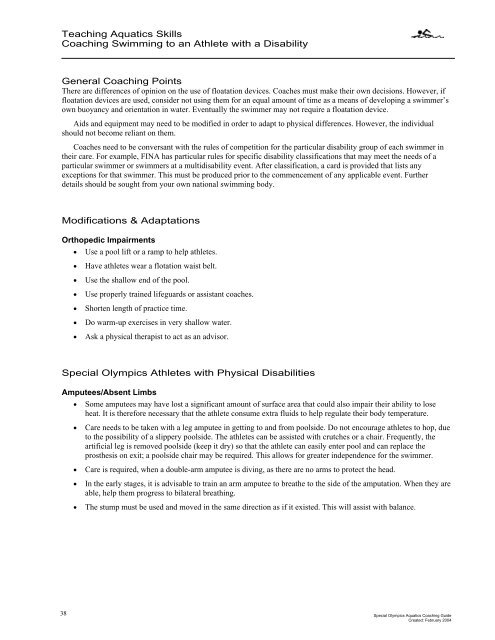Aquatics Coaching Guide - Special Olympics
Aquatics Coaching Guide - Special Olympics
Aquatics Coaching Guide - Special Olympics
Create successful ePaper yourself
Turn your PDF publications into a flip-book with our unique Google optimized e-Paper software.
Teaching <strong>Aquatics</strong> Skills<br />
<strong>Coaching</strong> Swimming to an Athlete with a Disability<br />
General <strong>Coaching</strong> Points<br />
There are differences of opinion on the use of floatation devices. Coaches must make their own decisions. However, if<br />
floatation devices are used, consider not using them for an equal amount of time as a means of developing a swimmer’s<br />
own buoyancy and orientation in water. Eventually the swimmer may not require a floatation device.<br />
Aids and equipment may need to be modified in order to adapt to physical differences. However, the individual<br />
should not become reliant on them.<br />
Coaches need to be conversant with the rules of competition for the particular disability group of each swimmer in<br />
their care. For example, FINA has particular rules for specific disability classifications that may meet the needs of a<br />
particular swimmer or swimmers at a multidisability event. After classification, a card is provided that lists any<br />
exceptions for that swimmer. This must be produced prior to the commencement of any applicable event. Further<br />
details should be sought from your own national swimming body.<br />
Modifications & Adaptations<br />
Orthopedic Impairments<br />
Use a pool lift or a ramp to help athletes.<br />
38<br />
Have athletes wear a flotation waist belt.<br />
Use the shallow end of the pool.<br />
Use properly trained lifeguards or assistant coaches.<br />
Shorten length of practice time.<br />
Do warm-up exercises in very shallow water.<br />
Ask a physical therapist to act as an advisor.<br />
<strong>Special</strong> <strong>Olympics</strong> Athletes with Physical Disabilities<br />
Amputees/Absent Limbs<br />
Some amputees may have lost a significant amount of surface area that could also impair their ability to lose<br />
heat. It is therefore necessary that the athlete consume extra fluids to help regulate their body temperature.<br />
Care needs to be taken with a leg amputee in getting to and from poolside. Do not encourage athletes to hop, due<br />
to the possibility of a slippery poolside. The athletes can be assisted with crutches or a chair. Frequently, the<br />
artificial leg is removed poolside (keep it dry) so that the athlete can easily enter pool and can replace the<br />
prosthesis on exit; a poolside chair may be required. This allows for greater independence for the swimmer.<br />
Care is required, when a double-arm amputee is diving, as there are no arms to protect the head.<br />
In the early stages, it is advisable to train an arm amputee to breathe to the side of the amputation. When they are<br />
able, help them progress to bilateral breathing.<br />
The stump must be used and moved in the same direction as if it existed. This will assist with balance.<br />
<strong>Special</strong> <strong>Olympics</strong> <strong>Aquatics</strong> <strong>Coaching</strong> <strong>Guide</strong><br />
Created: February 2004
















